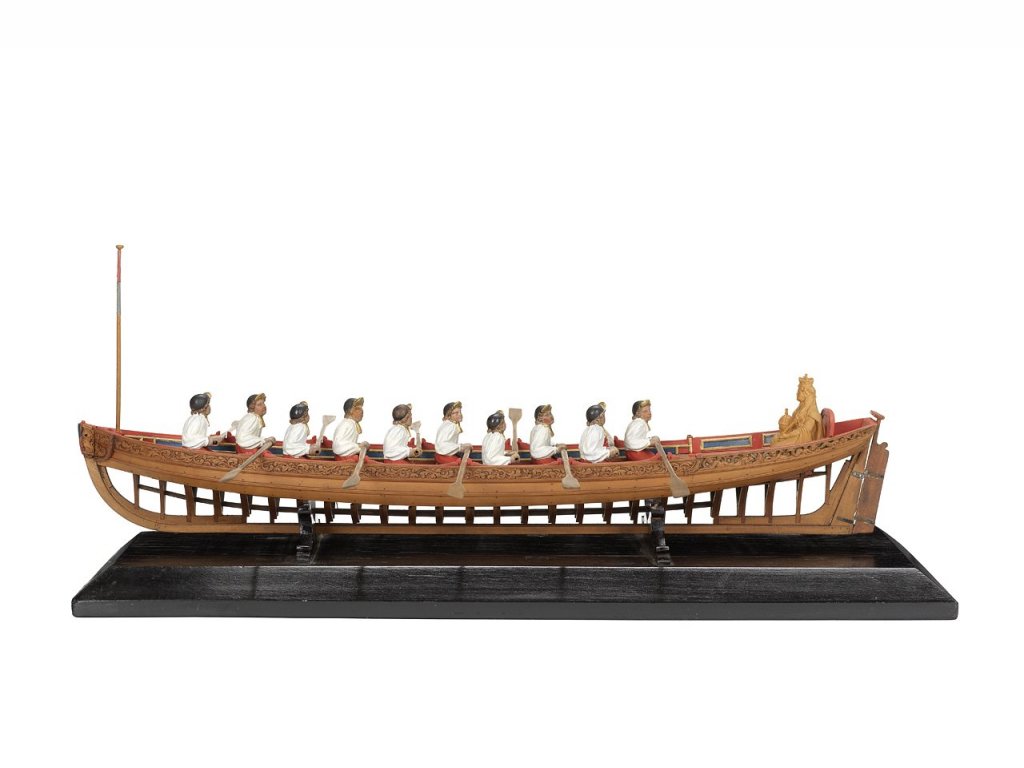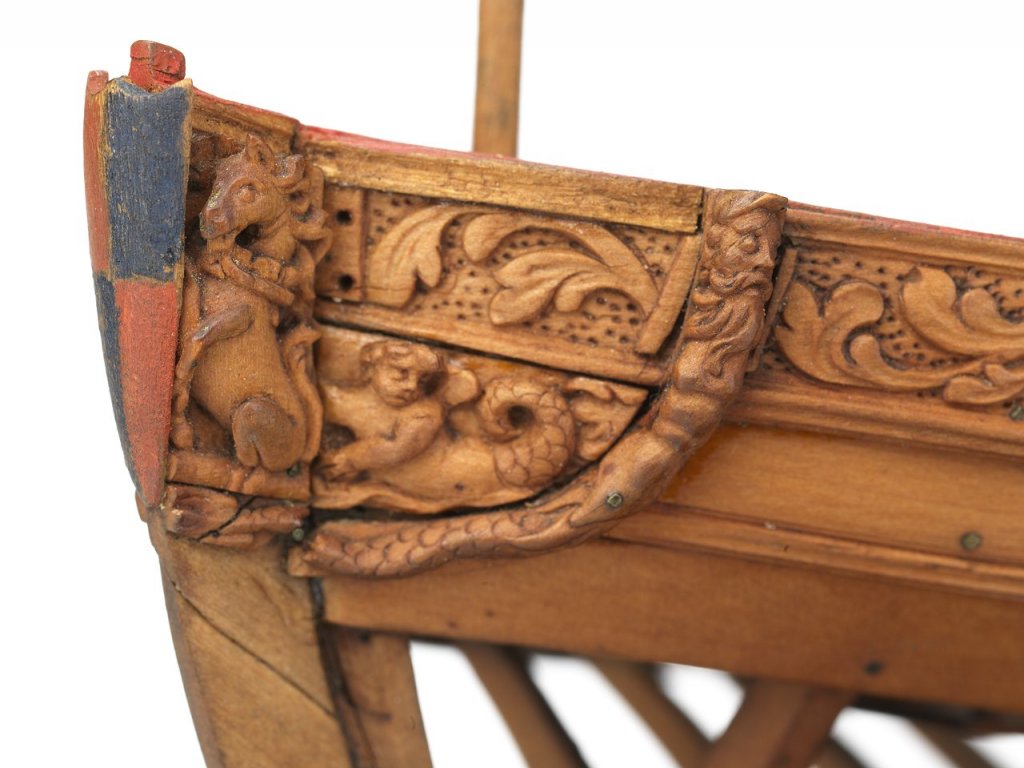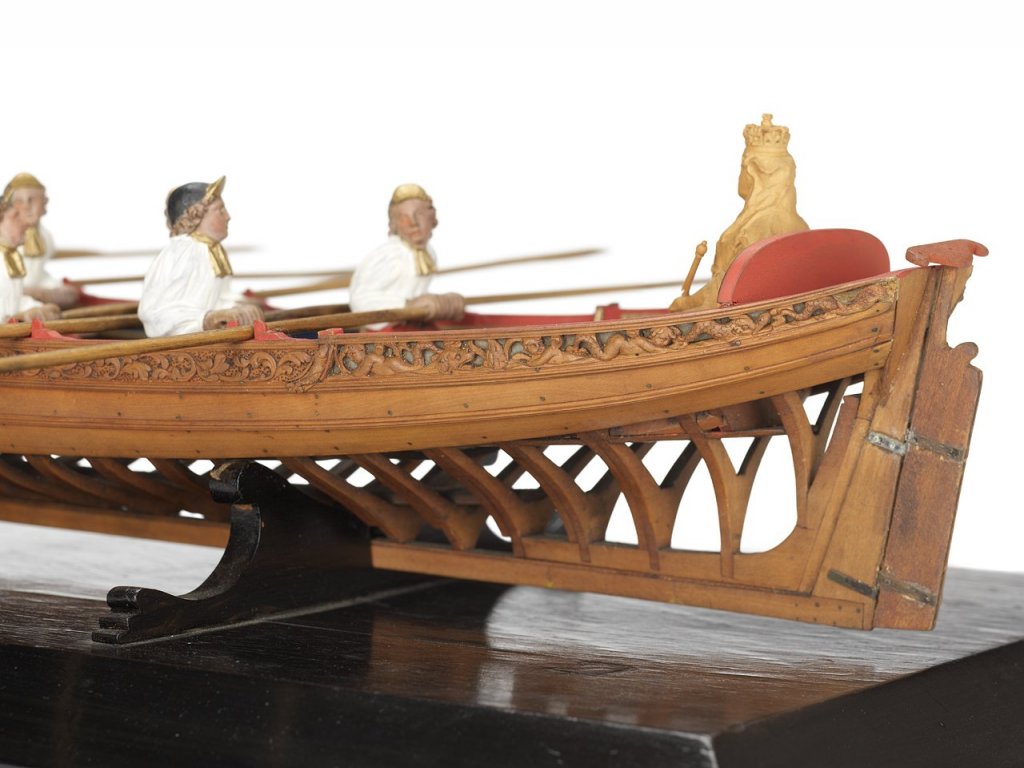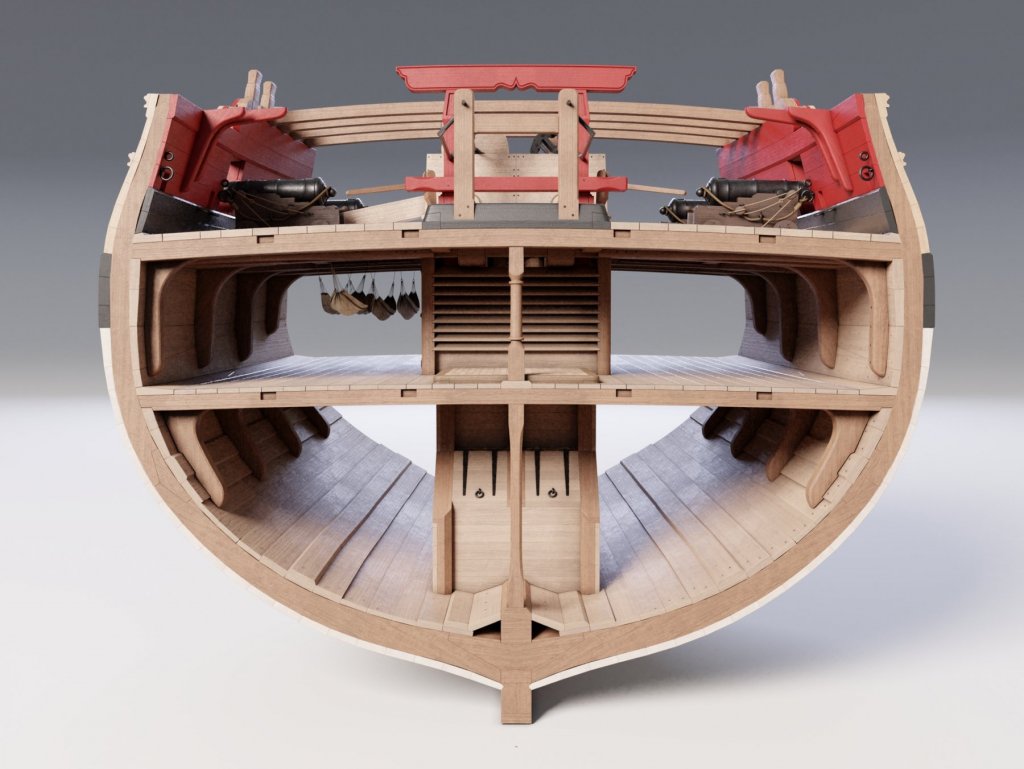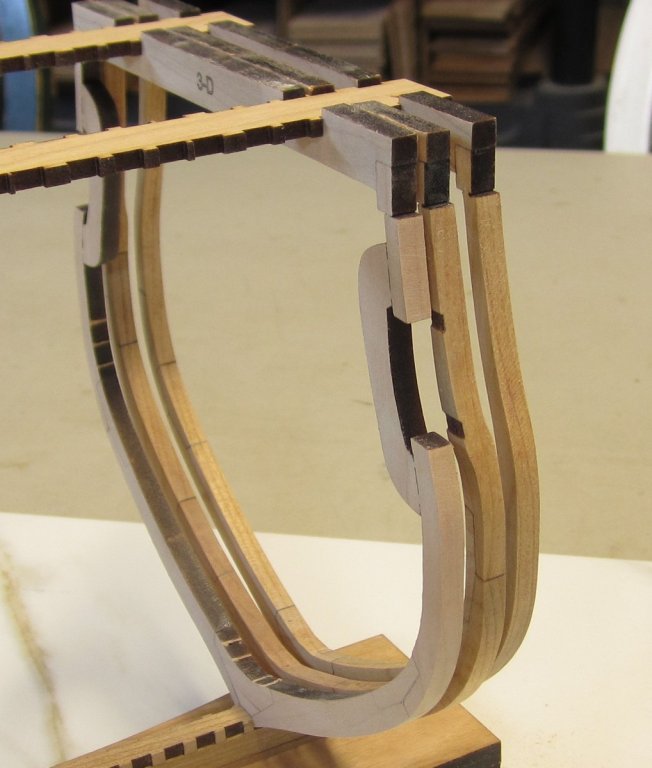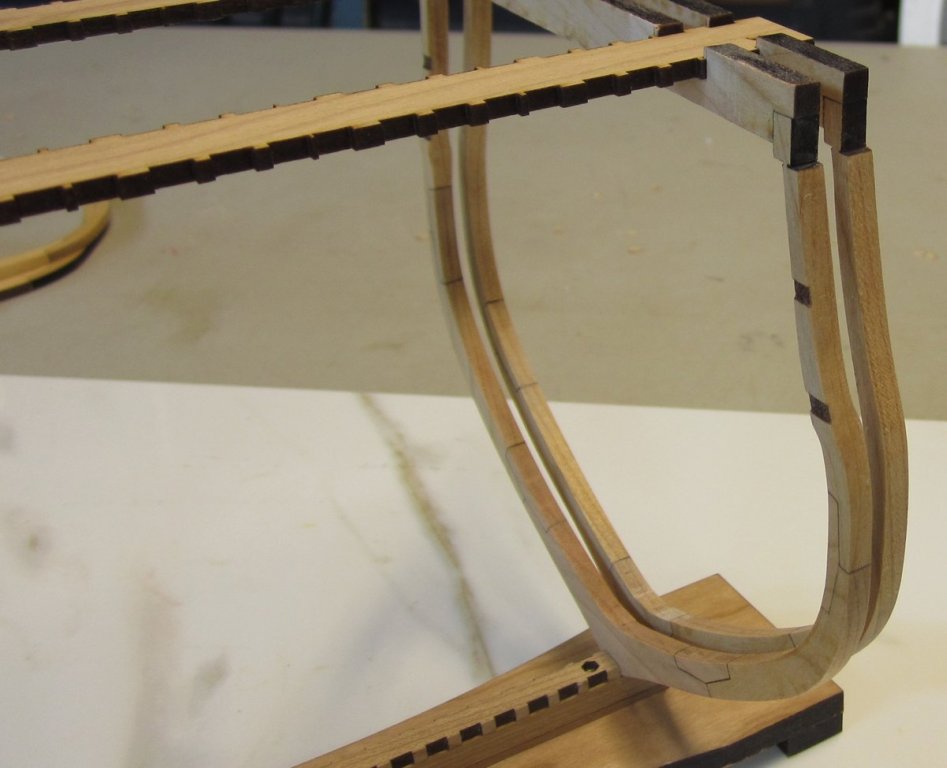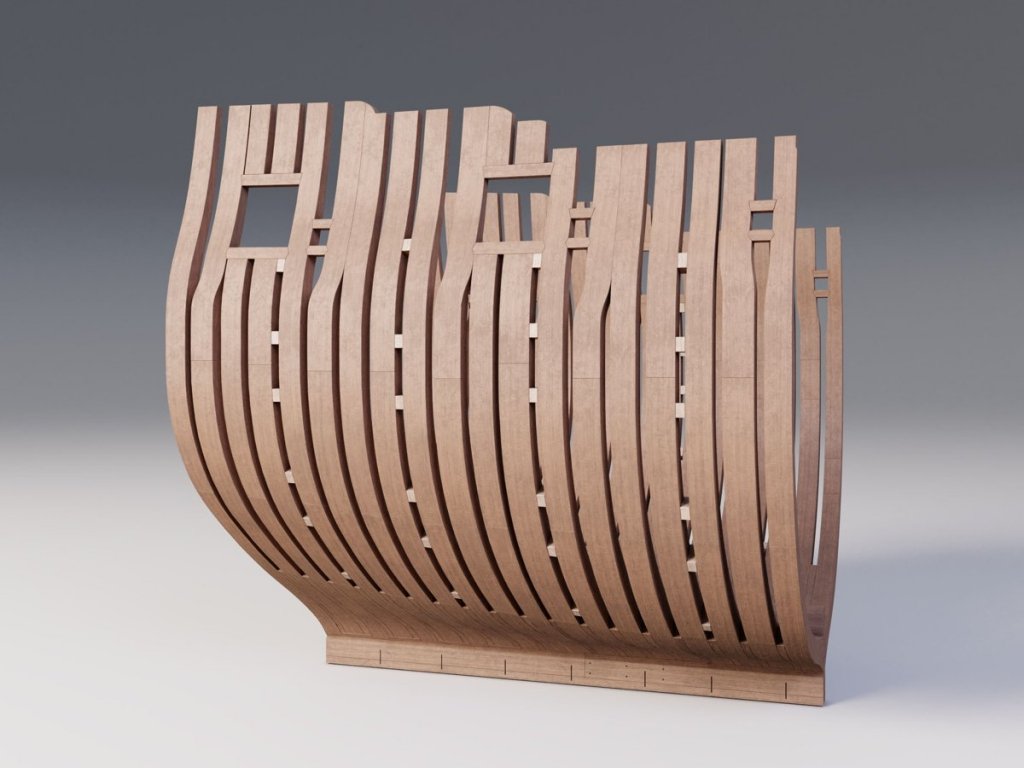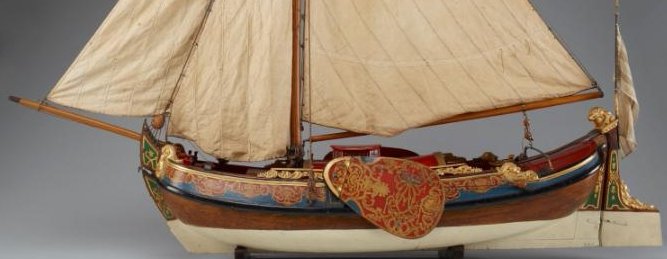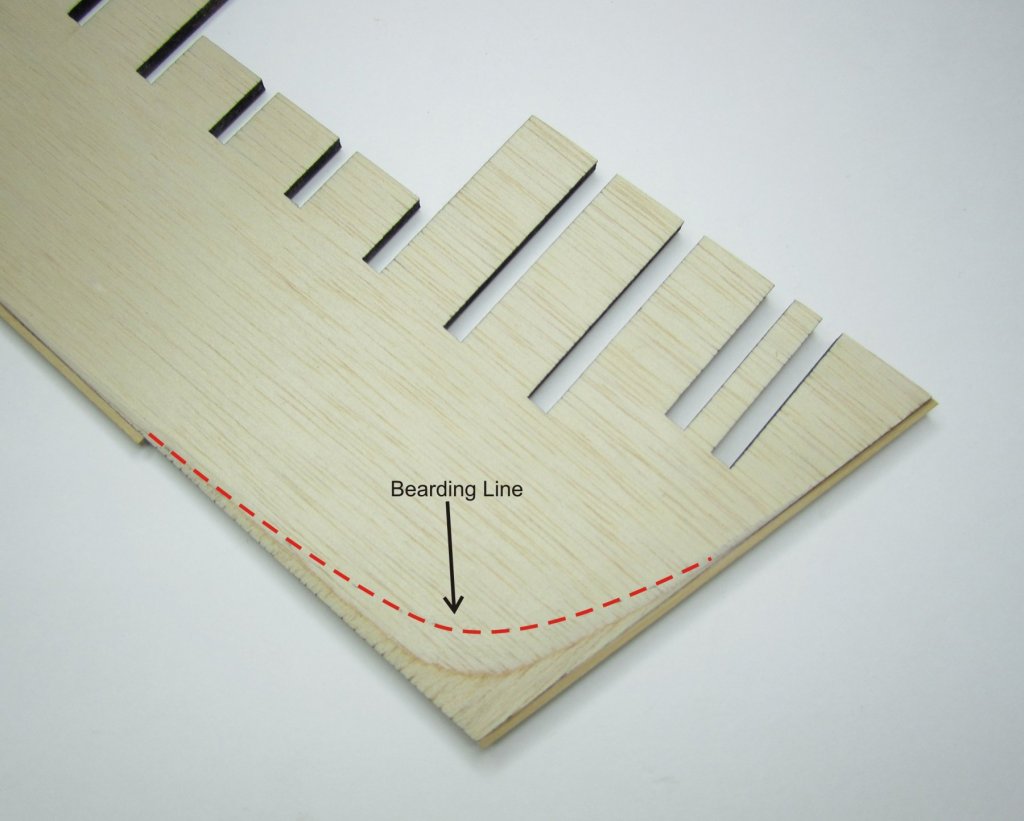-
Posts
9,662 -
Joined
-
Last visited
Content Type
Profiles
Forums
Gallery
Events
Everything posted by Chuck
-
The molding should have added only 1/32" as it was 1/32" thick so I would suggest another 1/32" less. I know you went with a different molding strip but that makes all the difference in the world when it comes to the thickness of the caprail when it is finished up. Chuck
- 47 replies
-
- queen anne barge
- Syren Ship Model Company
-
(and 1 more)
Tagged with:
-
Nicely done Sam.....try and keep it on the table top from now on though.... You might even want to sand those frames and caprail down even thinner if possible. The thinner it is the more elegant it will look.
- 47 replies
-
- queen anne barge
- Syren Ship Model Company
-
(and 1 more)
Tagged with:
-
And before you get too far ahead, Here are some pictures of another Contemporary Queen Anne Style Barge with a different color scheme. This also served as inspiration for mine but I noticed I didnt include any images of this one in my instructions. Note the absence of a flying transom. But more interesting is the carved details that are taken all the way up towards the stem. Also note the additional carvings at the stem. Maybe one of you ambitious lads are up to this challenge. A little inspiration as this one really inspired me while building and designing the kit. I almost used that interesting tiller.....check it out!!! The queen anne figure is NOT original to the model and it was a replacement for the lost original. So they left it unpainted. But the other figures are all contemporary and original. I designed a what I hope is a great set of bones for you folks (which is the stage that Ben is at right now) but if you look around.....check out the museums... there are unlimited varieties of looks and decorations that this kit can be turned into....should you desire. I look forward to seeing some interesting and different iterations. But I do like what I went with as well. WAS IT EVIL OF ME TO POST THESE......ENJOY!!!!
- 74 replies
-
- queen anne barge
- Syren Ship Model Company
-
(and 1 more)
Tagged with:
-
That looks really really good Ben. It looks perfect. Careful removing those frame centers.....its the fun part.
- 74 replies
-
- queen anne barge
- Syren Ship Model Company
-
(and 1 more)
Tagged with:
-
Not seeing teh plans it would be impossible to tell. I dont think it will matter much either way in the final model.
- 130 replies
-
You need to trace them ina vector program like Corel Draw which is what I use. You just cant scan them etc. You need to use a drawing program or Cad program which when finished has vector lines. Those vector drawings are then saved as DFX files and sent to the laser cutter. But when you are tracing them and developing the part templates you must compensate for the kerf of the laser and char after its removed so once sanded the part is the correct size. So in most cases you are drafting slightly oversized. Most laser cutter companies like Boss laser have tutorials on their sites and so does Epilog. They wont teach you corel draw but what they have is quite useful.
- 130 replies
-
There will be a total of 20 frames in this cross section. It is a pretty robust section of the hull. Eleven of those frames are plain square frames, style one construction. There will be five frames with shifted or bent top timbers...Style 2. And finally four broken frames where the ports will be located.....style three. Style 3 is shown below. The concept seemed to work just fine. You can see I didnt even finish sanding the inside of the frame or apply any finish to it yet. I was just testing the concept. Once the port sill and lintel are added the safety tabs on the inside of the hull can be cut away. I dont think it will be too hard to do but given the tight space maybe but this will be better determined once I get that far. Now that the three styles of frames have been tested and approved....I can slowly move forward with drafting the remaining 17 frames. Its just busy work at this point. Having said that, this initial prototype will now be discarded and I will begin again with a new one after making a few minor tweaks. And this is how I design and bring a new project forward. This next rendition should be the final for all the framing so I will not be making yet a fourth iteration. In the meantime...have a look at one of Dennis' wonderful renderings of this cross section. This time with a lot more trimmings and you can see what the final will look like. Why build one when these renderings look so real???? Makes my actual wood version look kind of boring!!!
- 130 replies
-
Thank you and enjoy the ropewalk....I was playing with mine today also, LOL.
- 130 replies
-
Its not really the case. The Winnie is already designed and finished. Its all about just building it now with maybe some minor tweaks. No heavy lifting needed. This one on the other hand is such a new concept for me since I never built a fully framed anything. I could have gone the same easy route that most go and just do a hahn style project but that is nothing new at all. So the brain challenge drafting and designing these elements as developed by David Antscherl is just as much fun as building the Winnie. I am very grateful that it isnt the full hull. Once I finalize the three slightly different frame design concepts for these three different styles of frame I will be in good shape. Then its just rinse and repeat......and I only have one more left to tinker with...... Today at my shop the guys all came over and I handed out some laser cut frames to them so they can build them at home. You missed that today but next time you come I will give you a few. Its great having a bunch of testors ready and available so I can watch them assemble my crazy contraptions while I observe any problem areas that might prop up. So far so good. I believe Larry will be building this prototype alongside me and I will be getting him started in a couple of weeks......its a huge help with the entire process and fun for me to watch. Mike brought his Winnie too!!! Which looks great.
- 130 replies
-
There will be three different types of frames. All with slight variations of my frame design concept. You have seen the first which is the typical square frame. This second type which are are only four or 5 have shifted top timbers....or bent top timbers. It is built very similar to the last frame I described and will be described in full in the instructions. It is shown below with the bent top timber. The other thing you might notice in this photo is the laser etched notches on the frame for the port sill and lintel framing. This should make adding the port sills easier although if you would like to, you can adjust the notch shape so it looks more like the traditional fish tail shape you see and expect. It all depends on how much realism you want to add depending on your experience. The other interesting pieces are the two notched registration strips that will span across the top of all the frames. I didnt see this on other fully framed projects and I thought it would be a nice addition. This is going to be very different than the stylized framing ala Hahn. The third and final frame style will be those that are broken with a space to accommodate the gun ports. I will be designing it so they can remain in one piece until after you insert the port sills and lintels. This will make more sense after I show pictures. This last version of my frame concept will be up next so I want to finalize the testing and get it done soon. You can see the bent frames and "broken or split" frames in this 3 d rendering. I am working from aft towards the bow so the next two frames will be those broken frames to accommodate the gun ports Chuck
- 130 replies
-
I forgot to mention that and wasnt about to take another video. But its not for the ends. Its for when you do larger ropes. Like the 2mm stuff. It may have more of a tendency to unwind slightly. So instead of just running some water down the rope after its laid up....I like to make a weak and very thin solution. I mix some white glue or even titebond in the cup of water....its still very watery and then run that over the rope. Once dry....no worries about unraveling.
- 22 replies
-
- ropewalk
- rope rocket
-
(and 1 more)
Tagged with:
-
Ah but that is the half hull.....not one of the other three full models. The crazy thing about these three models is that none of them even match in size or scale or shape. They are all slightly different so its pot luck if they any one particular set of lines will be considered correct. But at least I will be able to say it was from one of them. Either way I will create a kit of a boeier and do have some time to wait as I am still working on the other two projects. But this is my back up boeier pictured below for any such kit should the Czar model info not make its way to me when I am ready to start.
-
I have already actually built the model pictured above......but I just built it in my head. Every step....by step. I know exactly what the pieces will look like and how all of that trim and molding will be added, etc. Its not very difficult at all. The hardest part of that project is convincing ANY one of the folks who can get the lines off the original contemporary models to do so. Any one of the three contemporary models will do. Or to even share the findings some of them already have. Its the toughest thing I have ever had to try and do. Its like these folks in that part of the world think they are keeping a secret cure for cancer or something. They are just very hesitant to share primary and secondary source information. Its very off-putting. I have never had this experience with any other museum, author or knowledgeable historian or scholar on the subject. I could get state secrets easier than it has been trying to get info on this boeier. It may be the thing that kills this project before it has a chance of getting out of my head and onto the workbench. Its probably why no really good kits or projects exists for these boats. Everything is "need to know" and "I am not sure I want to share" type of stuff. Its very unfortunate. And I am actually willing to pay for the info....if they wait too long I am sure some other not-so-ethical group will try and find a way to steal it though. So hopefully they wont hold out too much longer.
-
- 607 replies
-
- winchelsea
- Syren Ship Model Company
-
(and 1 more)
Tagged with:
-
That Echo Cross section and how it is presented is exactly how I plan on presenting the Pegasus kit. Literally the same. One side planked and one side open framed.....Its beautiful. Chuck
- 130 replies
-
I am not saying everyone is cheap or even mean to suggest Ives is. Please dont get the wrong idea. I Just want to point that out right away. His last two suggestions were just a good point to mention that things are getting a bit crazy and overwhelming with the wish lists. I got this covered. The kit will be a very nice project that is affordable and very easily upgraded. Mostly each builder will be able to do so with the tons and tons of info out there on Pegasus. Sure it would be much easier for most if I was able to do the extra work and put it all in the box...but then you will probably be looking at a $350-$375 cross section kit...rather than $225. Which w0uld not be an issue for some of you but most would just say no way....and I would not sell many kits. But let me work on the "base" version first and I can always add other features once it is all done....for an extra price of course. But I can tell you for sure that I wont be plating the kit or doing any masting and rigging. I am sure you guys can cover that aspect and do a fantastic job of it on your own. In fact I learned a lot about the market with the Cheerful and Barge kits. So many people want so many different things its not possible that a kit that comes in a single box will satisfy everyone. So like the Cheerful, I am thinking about oferring this Cross section in installments. - Base starter package with all framing parts and keel with build board - Exterior details package - planking and details -Interior details package - deck framing and fittings -adition one-off extra upgrades - to come much later This way it will be possible for even just a small price that someone could buy the framing and just bash/scratch build everything else. And it would be in everyones budget hopefully. I am also considering breaking down the Barge kit into two or three installments for the same reason. But for now I will keep it as is. I really want to try and make this so you guys have the most options and wont balk at the price tag. I am not calling anyone in particular cheap....but just as an example...I have guys asking me if they can just buy 6 feet of rope or just five 1/4" single blocks so they dont have to spring for an entire package. Its really crazy. Because after cutting them a six feet portion I would be able to somehow sell the remaining 14' in my scratch and dent section. I am surprised every day by the unusual requests and most are aimed at finding a way to save a few bucks. I get it...things are tough for some folks. I am not trying to minimize this. I am trying really hard to think outside the box within reason because you guys would be amazed how much this matters and the large number of requests I get. But I just cant sell you five blocks at .40 cents each and mail them in a regular envelope with a 50 cent stamp so you wont have to pay the regular shipping.
- 130 replies
-
Yes it was but, dont relate this to what your traditional kit might look like. There are dozens of people asking for dozens of things....and the kit can not be everything for everyone. Its kind of funny actually. Who wants holly...who wants masts and rigging...who wants copper plates...Pump details...a boxwood option....the list is endless. The beauty of the hobby is that any of you can very easily bash a kit like this to include copper plating. Or buy a few sheets of Holly to plank it with, or whatever else. What you guys dont realize is that with every upgrade it will add $$$ to the cost of a kit. For example, many have balked at the price I am charging for the barge. They dont understand how its different than other kits and what it takes to MFG it. I would like to keep this kit reasonably priced for the majority of builders...and not push this into the realm of where only 15% of the market will be willing to buy it or could afford it. I am shooting for the $225-$250 range....but you guys can bash it easily enough. I really dont mean to sound harsh but I wanted to let you know its a bit overwhelming and if you guys look back on the shear number of requests...thats a lot of upgrades and work for what most wouldnt want to pay more than five bucks extra for. Overwhelmed in New Jersey......
- 130 replies
-
Pretty much from scratch...but it was really good to have David's drafting on the parts first. That saved lots of time although I basically had to redo them to add the kit features you see. On projects like the Winnie, you basically start with the original drafts...import them into Corel draw and start designing....just like if you put a piece of tracing paper over a paper copy of the draft and used a pencil. I am just using a mouse instead. Makes erasing mistakes a lot easier.
- 130 replies
-
Its actually David's drafting and much of the original drafts are also used. But yes that would in my opinion be a very boring topic. But thats just me. Its just a lot of trial and error and computer drafting in Corel Draw. I usually try many iterations of any given feature before going with it. These frames concepts went through dozens of tweaks and redesigns before I arrived at what you see in the photos. The keel parts were about half a dozen different designs. Most of those tries end up in the trash....lots of waste wood. And it feels a lot like this after each and every failure....
- 130 replies
About us
Modelshipworld - Advancing Ship Modeling through Research
SSL Secured
Your security is important for us so this Website is SSL-Secured
NRG Mailing Address
Nautical Research Guild
237 South Lincoln Street
Westmont IL, 60559-1917
Model Ship World ® and the MSW logo are Registered Trademarks, and belong to the Nautical Research Guild (United States Patent and Trademark Office: No. 6,929,264 & No. 6,929,274, registered Dec. 20, 2022)
Helpful Links
About the NRG
If you enjoy building ship models that are historically accurate as well as beautiful, then The Nautical Research Guild (NRG) is just right for you.
The Guild is a non-profit educational organization whose mission is to “Advance Ship Modeling Through Research”. We provide support to our members in their efforts to raise the quality of their model ships.
The Nautical Research Guild has published our world-renowned quarterly magazine, The Nautical Research Journal, since 1955. The pages of the Journal are full of articles by accomplished ship modelers who show you how they create those exquisite details on their models, and by maritime historians who show you the correct details to build. The Journal is available in both print and digital editions. Go to the NRG web site (www.thenrg.org) to download a complimentary digital copy of the Journal. The NRG also publishes plan sets, books and compilations of back issues of the Journal and the former Ships in Scale and Model Ship Builder magazines.





